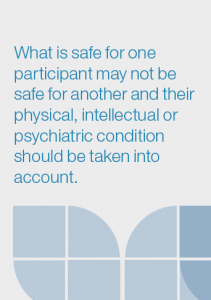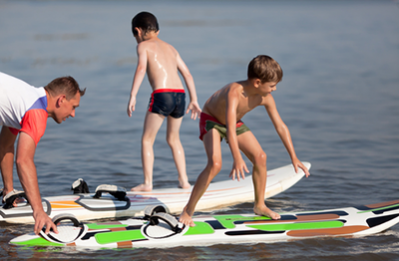No one is expected to foresee the unforeseeable, only to take reasonable precautions considering both the activity and the particular participants involved. What is safe for one participant may not be safe for another and their physical, intellectual or psychiatric condition should be taken into account.
The Department of Human Services (Vic) provide the following guide to assessing the risk level of activities. These are to be used as a guide but not to restrict individual’s participation if they have the skill and ability to participate.
Preparation required for low risk activities:
- Check medical information form;
- Check and have on hand emergency medical information form;
- Check participant’s medical records with them and their parents/ caregivers;
- Check that the first aid, safety and activity equipment is in satisfactory condition;
- Brief, instruct and prepare participant for the activity; and
- List and have available the necessary emergency contacts (Police, State Emergency Service, Park Manager/Ranger).
Preparation required for moderate to high risk activities:
- Check medical information form;
- Check and have on hand emergency medical information form;
- Check participant’s medical records with them and their parents/ caregivers;
- Check that the first aid, safety and activity equipment is in satisfactory condition;
- Ensure staff delivering program hold appropriate qualifications and/or experience for each activity;
- Brief, instruct and prepare participant for the activity;
- List and have available the necessary emergency contacts (Police, State Emergency Services); and
- Obtain parents/care givers consent on form, or at least make sure that parents/ caregivers are fully informed of the range of activities that the participant will be involved in during the program.
Careful consideration should be given to including these activities as part of a sport or active recreation program.
It is almost impossible for any leader to be aware of all the characteristics and implications present in working with individuals with disabilities. The abilities of people with a similar disability may vary greatly from one person to another. It is not possible and also not appropriate to have a set of clear guidelines that outline the precautions, procedures and liabilities that relate to participants with a particular impairment. These will need to be determined for each individual and will be dependent on the participant’s previous experiences, abilities and limitations due to impairment and their life experiences.
However there are broad general principles that apply in determining what precautions and procedures should be observed and the legal liabilities that may apply.
LOW RISK ACTIVITIES:
- Ball games
- General games
- Swimming (in a pool)
- Volleyball
- Cooking
- Athletics
- Aerobics
- Team Sports
- Bowling
- Cricket
- Basketball
- Fishing (except rock fishing)
- Football
- Golf
- Tennis
MODERATE TO HIGH RISK ACTIVITIES:
- Bushwalking
- Canoeing
- Carnival rides/Luna Park
- Horse riding
- Camp fires
- Ice skating/Roller skating
- Orienteering
- Rope course
- Snow activities
- Swimming (in natural water)
- Trampolining
- Rock climbing/abseiling
- Archery
- Dingy sailing
- Scuba diving
- Water skiing
- Board Sailing
- Bushwalking (if overnight)
- Cycling tours (if overnight)
- Snorkelling
- Hayrides
UNACCEPTABLE ACTIVITIES:
- Shooting
- Boxing
- Kick boxing
- Martial arts
General principles that apply for preparation for a group to participate in special activities:
1. KNOW THE GROUP
Find out as much as possible about the group participating in the program as you can. Coordinators and parents or caregivers are a great source of information in understanding how the specific disability affects the individuals. Know the participant’s previous experience in the activity or similar activity. Talk to the participant to determine their motivations for participation in the activity.
2. KNOW THE ACTIVITY
Be well briefed on the skills of the activity and be competent in the use of these skills. Understand the components of the activity so that you can teach them to someone else. Refer to the Adventure Activity Standards for further information relating to the delivery of outdoor recreation activities – www.outdoorsvictoria.org.au
3. KNOW THE EQUIPMENT
Understand the equipment required for an activity and how the equipment works. This includes the equipment required for protection and safety. Protection and safety equipment may include helmets, personal flotation devices, or knee and arm guards.
4. CLOTHING
Know about the appropriate clothing required for an activity, for example:
- warm and water proof clothing for activities in the snow
- wet suits or life jackets for a range of aquatic activities
- protective clothing for a range of contact activities


